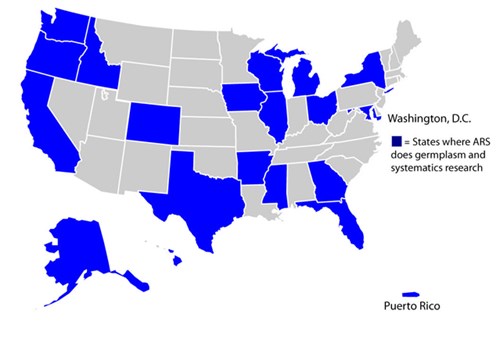ARS Research Programs in Systematics and Collections
Agricultural Research Service programs for systematics and collections fall mainly under two national programs—Plant Genetic Resources, Genomics, and Genetic Improvement (#301) and Food Animal Production (#101). There are more than 15 categories of collections, including plant and animal germplasm, bacteria, fungi, nematodes, molecular reagents, parasites, and protozoa. Every day, scientists working in nearly every national program make use of collections as sources of genes, information, and reference materials for their research.
Stewardship of the ARS scientific collections is a major concern for the agency and the country. Priorities for the programs include identifying and filling gaps in germplasm collections, especially wild relatives of crops that are endangered by habitat loss; preservation of stored germplasm; improving protocols for germplasm regeneration; ensuring the accuracy of collections; and expanding the availability of germplasm information and genetic material.
ARS works with national and international committees to identify the most important gaps in germplasm collections and organize collecting expeditions and exchanges to fill them. This is helping to ensure the availability of genes that may one day fill needs that today’s breeders have not even conceived of yet. The agency is also working to promote more international germplasm exchanges.
In addition, ARS is using its unique resources to mentor and train researchers and technicians around the world, which will help other countries expand their efforts to preserve and protect native germplasm.
The agency’s Germplasm Resources Information Network (GRIN), currently an important source of information about ARS plant germplasm, is becoming the centerpiece of international cooperation for sharing information about plant germplasm through the GRIN-Global project. GRIN-Global will enable genebanks worldwide to manage information about plant germplasm more effectively.
Though ARS’s animal germplasm collections are not as old or extensive as the plant and microbial collections, major efforts are being made to identify, preserve, characterize, and distribute animal germplasm. Research is focusing on developing ways to improve the viability of cryopreserved germplasm for some species.
Development of international databases for animal germplasm is also gaining momentum. Current livestock database-building efforts are being coordinated among ARS, Canadian, and Brazilian scientists to establish international standards and to share information.
Enhancing the security of ARS’s long-term backup sites for germplasm collections is another important objective of the national programs. The researchers at the ARS National Center for Genetic Resources Preservation lead the agency’s work on long-term germplasm storage to help ensure the future of genetic diversity.

"ARS Research Programs in Systematics and Collections" was published in the January 2010 issue of Agricultural Research magazine.






